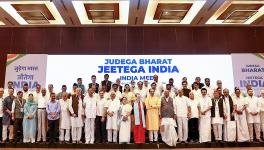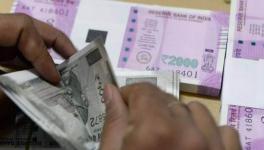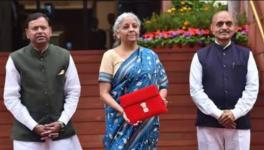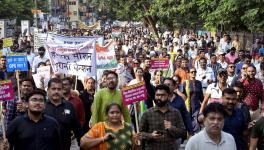Government Must Spend More to Help People in This Hour of Crisis
Representational use only.
Even as the second wave of Covid-19 subsides, the economy continues to be in doldrums. According to the data released last month, India’s GDP contracted by 7.3% in FY 2020-21. Unemployment rate had reached 11.9% in May 2021 jumping from 8% in April 2021. The rate of employment had not even reached the pre-pandemic level before it began to decline again in January 2021. From 400.7 million in January, the number of employed people came down to 375.5 million in May.
Struggling with dire economic conditions and a health crisis, people of India have significantly reduced their expenditure. As a result of fall in incomes, job losses and high inflation, India’s per capita real private final consumption in 2020-21 regressed to its levels three years ago. Recent data from the Centre for Monitoring Indian Economy (CMIE) shows that India’s per capita real private final consumption expenditure (PFCE) was measured at Rs 55,783 during the year, levelling with its value of Rs 55,789 in 2017-18. PFCE reflects consumer spending and includes final consumption expenditure of households and non-profiting institutions serving households (such as temples and gurudwaras).
In simple terms, this means that an already existing demand crunch within the Indian economy is becoming even more severe.
In order to protect people from a severe crisis, the left democratic movement has been demanding that the government should ensure adequate medical facilities, beds and oxygen in hospitals, amendments to the anti-people and pro-corporate vaccine policy, recruitment of necessary health personnel, banning retrenchment and wage-cuts of workers etc. In addition to these, they have also demanded that: a) cash transfer of Rs 7500 per month be made for all non-income tax paying families, and, b) 10 kg of free food grains be given to per person per month until November 2021.
Let us consider the expenditure that the Indian government will incur on these two measures, if they are to be undertaken.
Expected Expenditure on Distribution of 10 Kg Food Grains
The total expenditure made by the government for distribution of 5 kg of food grain under the Pradhan Mantri Garib Kalyan Anna Yojana (PMGKAY) to the beneficiaries covered under Targeted Public Distribution System (TPDS) (in addition to distribution of food grains under the National Food Security Act) for a period of eight months from April to November 2020 was Rs. 1,22,123 crore. A total allocation of 322 LMT of food grain was made, out of which a total of 297.5 LMT of food grain had been distributed.
Considering this cost, the distribution of 10 kg food grain under the scheme for eight months would lead to a total expenditure of Rs 2,44,246 crore.
Expected Expenditure on Cash Transfer to Non-tax Paying Families
Let us calculate the expected expenditure that the government will incur on payment of an income of Rs 7500 a month to non-tax paying families.
Data produced by the Central Board of Direct Taxes (CBDT) revealed that the total number of people liable to pay income tax in India are 1.46 crore. For simplicity, let us assume that there is only one tax paying member in each household. This means that the total number of tax paying households will be 1.46 crore.
Now, let us calculate an indicative figure for non-tax paying households in India currently.
According to Census 2011, the total number of households in India were 24.7 crore and the total population was 121 crore. Population projection for 2021 estimates the total population in the year 2021 to be 136 crore. With these figures, the number of households in India are projected to be 27.8 crore in 2021.
According to previous calculations, the number of tax paying households are 1.46 crore. Therefore, the number of non-tax paying household will be around 26.3 crore. A transfer of Rs 7500 to every non-tax paying family for a month would lead to a total expenditure of Rs 1,97,265 crore.
(For the sake of simplicity, we have assumed one tax-paying member in each tax-paying family. Even if a proportion of tax-paying families have more than one tax-paying members, this expenditure will increase only by a small measure.)
The following table shows the total expenditure on both schemes for a month – distribution of 10 kg food grain for eight months (April-November) under PMGKAY and direct transfer of Rs 7500 per month to non-tax paying families.
The total expenditure on the two measures for a month comes down to Rs 2.28 lakh crore. The total expenditure on the transfer of 10 kg additional food grains for eight months under PMGKAY will lead to an expenditure of Rs 2.44 lakh crore. This would mean an added expenditure of Rs 1.22 lakh crore over what the government is already spending on distributing 5 kg food grains under PMGKAY. And if the income transfer scheme is to be implemented for a period of three months, the total expenditure would be around Rs 5.9 lakh crore.
Concession to Corporates
Instead of direct spending, India relied on giving incentive for investment by the private sector through tax breaks and other doll outs. Now, let us compare the above figures with the different kinds of concessions that the Indian government has been extending to the corporate sector over the last few years.
In September 2019, the government announced a reduction in corporate tax rates from 30% to 22% for domestic manufacturers and from 25% to 15% for new manufacturing units. The expected revenue loss as a result of this measure was Rs. 1.45 lakh crore.
The revenue forgone to corporates in the form of tax exemptions and incentives for FY 2017-18 and FY 2018-19 stand at Rs. 93,642.50 crore and Rs. 1.08 lakh crore respectively. The revenue forgone to corporates in FY2019-20 is estimated at Rs. 99,842.06 crore in Budget 2021 document.
As per RBI data, scheduled commercial banks have written-off loans of Rs. 2.36 lakh crore, Rs. 2.34 lakh crore and Rs. 1.15 lakh crore during FY2018-19, FY2019-20 and the first three-quarters of FY2020-21 respectively.
The following table gives estimates of corporate concessions by the government over the last few years.
Since the previous lockdown, prominent economists have exhorted the government to increase its spending to effect a demand stimulus required to sustain economic growth. Many have urged the central government to elevate its spending on cash and food transfers to people for immediate relief. Impoverished due to repeated shutdowns and incomes drying up, people will spend this money to fulfil their everyday needs resulting in an immediate stimulus in demand.
However, the government has been highly reluctant on this front. As per the data released by International Monetary Fund, India had spent merely 3.1% of its GDP on fiscal measures taken in response to COVID-19. The US and UK spent a whopping 16.7% and 16.3% of their GDP respectively. Even developing countries such as China, South Africa and Brazil had spent 4.7%, 5.5% and 8.3% respectively.
The Indian economy had been facing a demand crunch since before the pandemic hit. High unemployment rate and low incomes have been responsible for dampening of demand in the Indian economy. A prolonged national lockdown last year, economic recession and loss of income and livelihoods have affected the demand within the economy. In this light, progressive economists and the left movement have been relentlessly asking the government to pump up spending to stimulate demand.
However, the current dispensation appears to be persuaded neither by economic logic nor by humanitarian crisis!
(The writer is an author and a Research Associate with Newsclick. The views expressed are personal. She can be reached on Twitter @ShinzaniJain.)
Get the latest reports & analysis with people's perspective on Protests, movements & deep analytical videos, discussions of the current affairs in your Telegram app. Subscribe to NewsClick's Telegram channel & get Real-Time updates on stories, as they get published on our website.
























